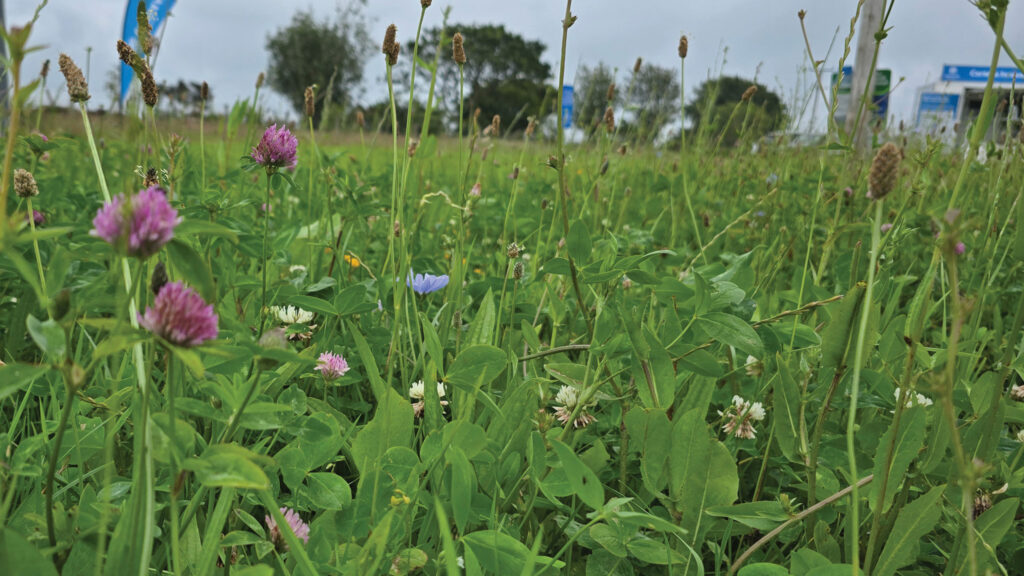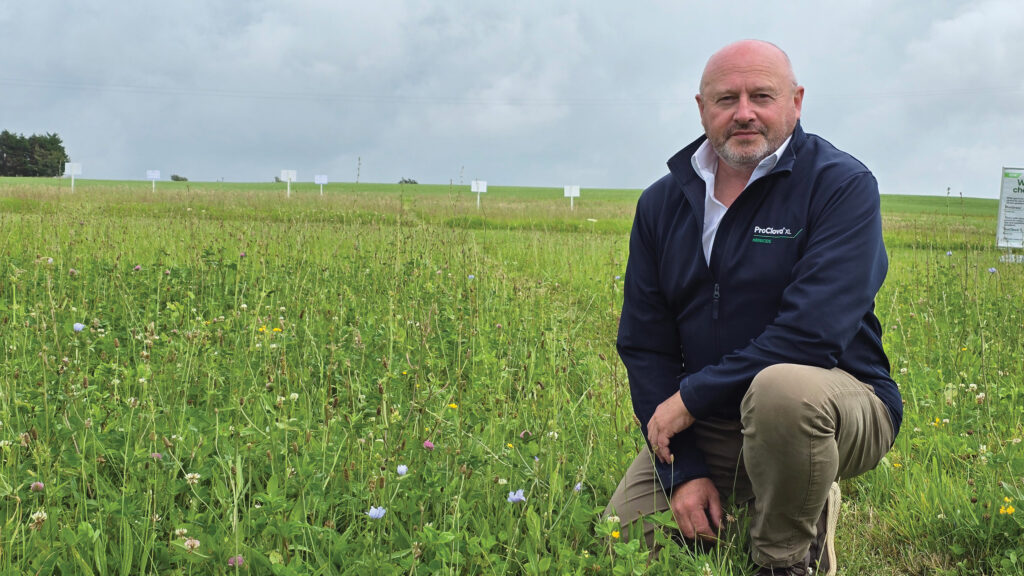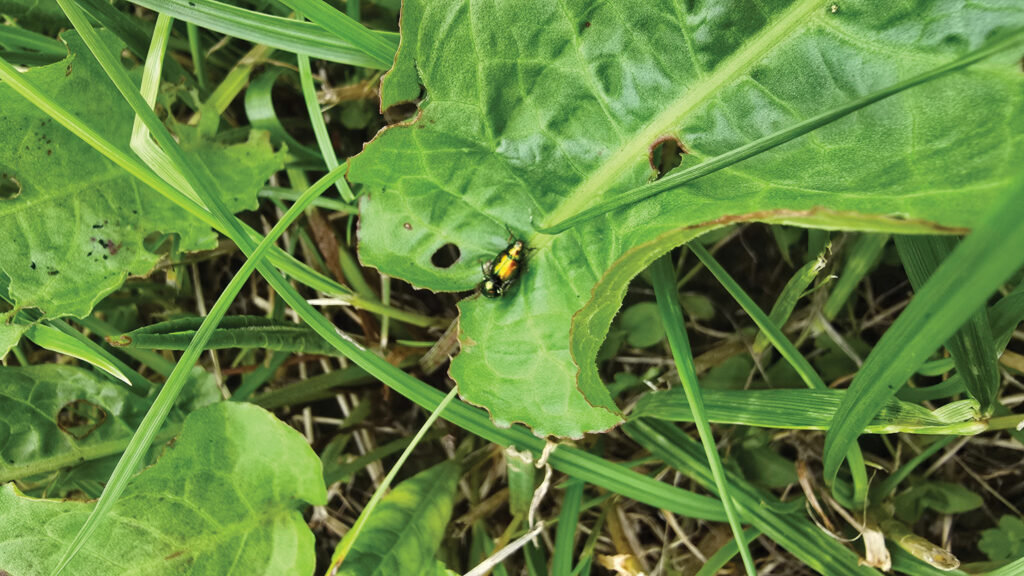Advice on managing weeds in clover-rich swards
 © MAG/Anne Dunn
© MAG/Anne Dunn Ensuring a valuable clover crop does not suffer while treating weeds such as thistles, docks, fat hen and buttercups is presenting a challenge for agronomists and livestock farmers alike.
“Many reseeds have clovers added into the seed mix, so you’ve got to have a solution that can kill all these weeds, be safe on the clover, and meet the increasingly stringent regulatory hurdles for new pesticides coming on to the market,” says Robin Bentley, category marketing manager at Corteva Agriscience.
See also: Tips for establishing white clover in a sward

Robin Bentley © MAG/Anne Dunn
Recent trials managed by Adas in Wales, looking at Corteva’s new clover-safe herbicide, have shown promising results for use in mixed swards.
Chicory and bird’s-foot trefoil recovered well after the new herbicide was applied, although plantain is negatively affected by its use.
“We’re not dealing with weeds in a grass-only situation – it’s grass plus clovers or grass in multispecies leys,” says Robin.
“So you’re looking at more protection for more plant species than ever before. It’s important to speak to your agronomist on how to manage that and find an approach that works for your farm.”
Timing of application
The trial has also shed light on the importance of timing of herbicide application.
Weed targets that exhibit active growth are better controlled than those sprayed when overnight temperatures dip below 8C, or where active growth is compromised, for example as a result of drought or pest damage.
Robin says this is important to know, to secure optimal weed control in a grass plus clover sward.
And it makes a highly effective, broad-spectrum, clover-safe herbicide a valuable tool to help farmers successfully establish and preserve clover populations in grassland.
Farmers will want the same levels of weed control with a clover-safe herbicide as they can get from conventional products that kill clover, he points out.
“That, though, can be a challenge, so I would advise them to work closely with their advisers to determine the best pathway for managing weeds in pasture,” he adds.
Preparing the ground
Brent Gibbon, business development manager at Nufarm, advises that the best option to protect clovers and other species in a herbal ley is to ensure the previous sward has been killed off properly.
He says this can be achieved either by using glyphosate – although this does not always manage to kill perennial weeds – or a combination product that uses glyphosate and 2,4-D.
To ensure the new ley establishes well after treatment, farmers are advised to ensure the soil pH is correct.
“This can be achieved by previous liming, which makes the ley more competitive compared with weeds such as thistles and docks,” he explains.
Once the ley is established, Brent advises spot treatment of weeds such as thistles and docks, depending on any scheme rules farmers have to comply with.
Tough weed control in new leys

© MAG/Anne Dunn
Docks and thistles can present a challenge to grassland productivity.
If there is more than 10% of these in a sward, they can become an infestation that can severely affect yield and productivity, according to Robin Bentley of Corteva Agriscience.
He says an additional challenge is managing these in newly sown leys, as different rules for crop protection apply, compared with established pasture.
“On new-sown leys, the regulators are concerned about herbicide run-off into watercourses, as there is less crop intercepting the spray,” explains Robin.
As a result, products approved for use on newly sown leys tend to have a lower use rate and shorter application windows.
Yet the weed spectrum in newly sown leys is much wider, with annual weeds as well as seeding perennials coming through.
Early control
When reseeding, it is important to consider how the ley can be sustained once it is established.
“Where weeds ingress, they replace grass, and productivity is going to be compromised if they are not dealt with at an early stage,” he says.
“If you don’t deal with the weeds when they’re small, they are going to be the big weeds once the grass is established.”
If they are left to grow, he explains, a different type of product could be required with a higher application rate.
At the same time, the amount of control may be a lot less than it would have been had the weeds been dealt with earlier.
“You’ve got to be looking at your reseeds as soon as the grass is coming through. Don’t leave it to the point where the weeds get too big, above 10cm, because you may not secure the full levels of control.
“Fat hen is a good example – as soon as fat hen gets beyond four or five leaves, it becomes a more difficult weed to control,” he says.
When reseeding, using glyphosate to burn down the old sward will significantly reduce the root mass of docks and thistles, Robin suggests.
This will then limit the emergence of these plants from root fragments, which can be harder to repress compared with those growing from seed.
Topping
Another management tool that may help when dealing with tough weeds is topping.
This can be more effective than, say, spraying docks that have been ravaged by dock beetle, which will lead to poor control, he says.
“In those situations, farmers are best advised to top and then spray when the regrowth comes through – it’s more even and you’ve got active growth.
“Good, clean leaves, undamaged by dock beetle, will be much more receptive to herbicide,” he adds.
Trials are under way to examine the value of topping creeping thistles before spraying.
“Topping tends to encourage more root shoots to come through,” explains Robin.
The trials will compare spraying post-topping with spraying and no topping, to determine the differences in control levels and overall costs.
“For successful and lasting perennial weed control, you want a [herbicide] solution that translocates well,” he says.
However, he points out that a product that gives fast top-growth kill is unlikely to translocate enough product into extensive root systems, which can lead to subsequent regrowth.
“Your adviser can further direct on this,” he adds.
Benefits of maintaining good soil cover
The most effective management tool for weeds in grassland, says Robin Bentley of Corteva Agriscience, is making sure there is a healthy, thick sward of grass so the soil profile is not open to the elements.
“Poaching, tractor wheeling, drought, overgrazing and overuse of manure can all open up the sward, enabling weed populations to come through,” he explains.
Grassland managers could also be reducing the competitiveness of grass by feeding it less nitrogen.
“If you’ve got grass varieties that aren’t so reliant on nitrogen, the chances are that they’re going to be less competitive to weed species.
“That too can be an invitation for weed species to come in,” he advises.
A more open sward is typical of multispecies leys, where a diversity of species is being encouraged.
“That will also encourage weeds to present themselves. To best manage that requires good grazing and grass management,” he adds.
